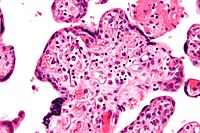
Photo from wikipedia
Maternal undernutrition during pregnancy followed by ad libitum access to nutrients during postnatal life induces postnatal metabolic disruptions in multiple species. Therefore, an experiment was conducted to evaluate postnatal growth,… Click to show full abstract
Maternal undernutrition during pregnancy followed by ad libitum access to nutrients during postnatal life induces postnatal metabolic disruptions in multiple species. Therefore, an experiment was conducted to evaluate postnatal growth, metabolism, and development of beef heifers exposed to late gestation maternal nutrient restriction. Pregnancies were generated via transfer of in vitro embryos produced using X-bearing sperm from a single Angus sire. Pregnant dams were randomly assigned to receive either 100% (control; n = 9) or 70% (restricted; n = 9) of their total energy requirements from gestational day 158 to parturition. From post-natal day (PND) 301 until slaughter (PND485), heifers were individually fed ad libitum in a Calan gate facility. Calves from restricted dams were lighter than controls at birth (P<0.05) through PND70 (P<0.05) with no difference in body weight from PND105 through PND485 (P>0.10). To assess pancreatic function, glucose tolerance tests were performed on PND315 and PND482 and a diet effect was seen with glucose area under the curve being greater (P<0.05) in calves born to restricted dams compared to controls. At slaughter, total internal fat was greater (P<0.05) in heifers born to restricted dams, while whole pituitary weight was lighter (P<0.05). Heifers from restricted dams had fewer growth hormone-positive cells (somatotrophs) compared to controls (P<0.05). Results demonstrate an impaired ability to clear peripheral glucose in heifers born to restricted dams leading to increased deposition of internal fat. A reduction in the number of somatotrophs may contribute to the adipogenic phenotype of heifers born to restricted dams due to growth hormone’s known anabolic roles in growth, lipolysis, and pancreatic islet function.
Journal Title: PLoS ONE
Year Published: 2021
Link to full text (if available)
Share on Social Media: Sign Up to like & get
recommendations!